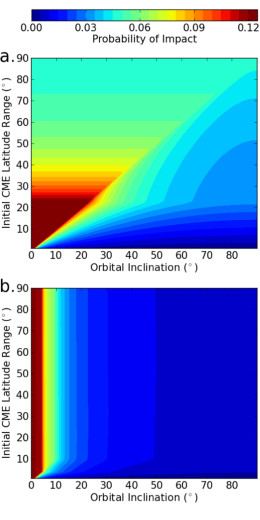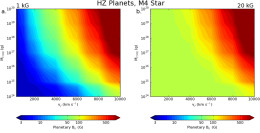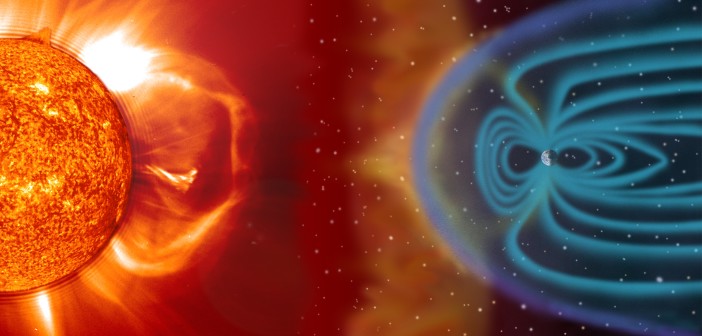Coronal mass ejections (CMEs), enormous releases of energy from the Sun, can have significant space-weather implications for Earth. Do similar storms from smaller stars — M dwarfs like V374 Peg, or the nearby Proxima Centauri — mean bad news for the planets that these stars host?
Volatile Stars
When plasma is released from the Sun in the form of a CME traveling toward Earth, these storms can be powerful enough to disrupt communications and navigational equipment, damage satellites, and cause blackouts — even with our planetary magnetic field to protect us! How might planets in the habitable zone of M-dwarf stars fare against similar storms?The first danger for an M dwarf’s planets is that the habitable zone lies much closer to the star: it can range from 0.03 to 0.4 AU (i.e., within Mercury’s orbit). Being so close to the star definitely makes a planet in an M dwarf’s habitable zone vulnerable to storms.

Colors indicate the probability of CME impact, for different different stellar latitudes where the CME originated vs. orbital inclination of the planet, (a) without any deflection, and (b) taking into account the CME deflection by the star’s magnetic field. Hanging out in an orbit aligned with the current sheet turns out to be a bad idea. [Adapted from Kay et al. 2016]
Dodging Deflected Storms
Interestingly, an important factor in the survival of an M dwarf’s habitable-zone planet is the plane in which the planet’s orbit lies. A team of scientists led by Christina Kay (NASA Goddard’s Solar Physics Laboratory and Boston University) recently modeled CMEs from V374 Peg, a mid-type M dwarf of roughly a third of the Sun’s mass and radius, to determine how the CMEs propagate and the probability that they’ll impact a hypothetical planet in the star’s habitable zone.
The team shows that traveling CMEs tend to be deflected by the star’s magnetic field. Instead of propagating purely radially outward, the CMEs are pushed toward the astrospheric current sheet — the minimum point of the background magnetic field — which moves around, but is generally located toward the stellar equatorial plane.
Kay and collaborators find that planet orbits roughly aligned with the current sheet therefore have a higher probability of getting hit by a CME: around 10%. In contrast, planets with higher-inclination orbits have CME impact probabilities around 1%. These probabilities translate to an impact rate of about 0.5–5 times per day for a habitable-zone planet around a mid-type M dwarf — which is 2–20 times the average at Earth during solar maximum!

Minimum planetary magnetic field strength required to sustain a magnetosphere twice the size of the planetary radius for different CME masses and speeds, for a 1 kG (left) and 20 kG (right) initial CME magnetic field strength. A typical CME requires a field strength of 10–100 G. [Adapted from Kay et al. 2016]
Is There Hope for Planet Habitability?
With this many CME impacts even outside of the current-sheet plane, how can a planet hope to survive? The key lies in having a strong magnetic field to protect the planet. Such a field would deflect the charged particles from the CME, preventing the CME from stripping the planet’s atmosphere.
Kay and collaborators calculate that a habitable-zone mid-type M-dwarf exoplanet would need a planetary magnetic field between tens and hundreds of Gauss — 1 to 2 orders of magnitude more than that of Earth — to protect itself from these CMEs: difficult to muster, but not impossible!
These results provide some interesting food for thought as we continue to discover new exoplanets orbiting M-dwarf stars.
Citation
C. Kay et al 2016 ApJ 826 195. doi:10.3847/0004-637X/826/2/195



2 Comments
Pingback: M dwarf CMEs hostile to life
Pingback: Stormy ‘Space Weather’ for M-dwarf Planets?